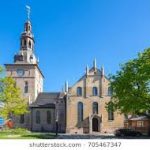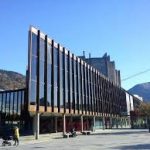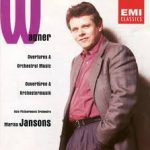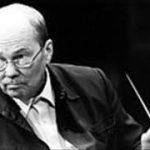My Musical Career|Part Forty
The Year 1991
This blog post covers most of the year 1991, which turned out to be a big year for the orchestra. In terms of recordings, we had two sessions – one as part of the 1990-91 season – the Shostakovich Symphonies No. 6 and 9, and the other a disc of Wagner overtures and preludes and excerpts from The Ring. I have already made mention of these recordings elsewhere, so will not dwell too much on these, other than to mention them in the appropriate time frame. There was also a short tour to the UK, where we played concerts in Glasgow, Scotland, and London and Northampton in England. In addition, we made a visit to the Bergen Festival.
The really big event of the year 1991 was our second tour to the United States, which took place in the late fall of 1991.(The tour itself will be covered in a separate post.) This was to be completely different tour than that of 1987, in which the orchestra had to kind of prove itself. That tour, while a lot of fun, took us to a lot of small towns like Muskegon, Michigan, Lima, Ohio, Sandusky, Ohio, and while there were a few large venues on the tour such as Chicago (although not Orchestra Hall), New York, and Washington, it was clearly a Class B tour in terms of hotels and in one venue, service. But I have already alluded to that in a previous post. This time, we came as an orchestra that had proven itself, and with a conductor whose name was a hot item in the music world. We had made it to the Class A list, and were treated accordingly.
1991 – Part A
As I noted earlier, the first part of 1991 was the second half of the 1990-1991 season. What comes to mind here are two events – our recording of the Shostakovich Sixth and Ninth Symphonies, and the death of King Olav V, which actually occurred during the one of the concert cycles in which we were playing the Ninth Symphony in preparation for recording it. The concert also included a performance of Scriabin’s Poem of Ecstasy. It was supposed to be a two concert cycle. We played the first concert, which went very well, but at its conclusion, as we were leaving the stage, word came of the death of King Olav V of Norway. He had passed quietly that evening. Naturally, all theaters and concert venues were closed for several days, which put paid to our repeat concert. Since it was not a public event, the recording sessions took place on the Saturday as scheduled, and any remaining items were done in a follow-up session early the following week.
A King’s Funeral
I had been playing with the Norwegian Chamber Orchestra for the past several years whenever a work called for timpani, and had actually gone to Bergen with the orchestra in 1988 when they played the last three Mozart symphonies in concert, both in Bergen and in Oslo. I was also to take part in an appearance with the Norwegian Chamber Orchestra in the summer of 1991, more of which later. The funeral of King Olav was to take place in the Oslo Cathedral (Oslo Domkirke), and the Norwegian Chamber Orchestra (Norsk Kammerorkester) was invited to perform. Naturally, I was asked to play timpani and this quite an honor.
As the orchestra and chorus were placed in the gallery around the organ, space for the timpani was naturally at a premium. I chose to use the three smaller Light Metropolitan Bs – 24, 26 and 29 inch, and managed to get them up there without too much of a problem. Terje Kvam conducted. He was the Cathedral organist and Choir Director at the time. I had known Terje since he was at one time chorus master of the Oslo Philharmonic Choir (1983-87), and had already worked with him several times. Being up in the gallery, all of us had a view of the congregation and of the funeral service proper. The king’s coffin lay on a church truck in the middle of the central aisle, just before the altar. It was covered with a Norwegian flag. The new king, Harald V and his wife Queen Sonja were in the front row along with their family and the old king’s sisters. Invited dignitaries included Prince Charles, representing Queen Elizabeth II and Britain; then-Czech President Vaclav Havel; then French President Francois Mitterand as well as Swedish King Gustav and representatives of the Danish royal family, and of course members of the Norwegian government. The Cathedral is large, but not overly large – at best it seats about 1200, and it was full. We played several movements of Mozart’s Requiem (the Requiem and Kyrie); the Amen chorus from the Messiah, and Variation IX – “Nimrod” from Elgar’s “Enigma Variations”. It was an impressive service and I still remember the pomp and circumstance of it (although this is more understated in Norway than in Britain). I also remember from the news reports that during the funeral procession from the Cathedral to Akershus Fortress, where the king was to be laid to rest, one of the mounted policewomen was killed when her horse reared up and fell on top of her in a freak accident. King Harald and Queen Sonja sent their sympathies to the woman’s family, but it made headline news. Had she been wearing a hard riding hat or helmet, she might have made it, but of course she was wearing the old style garrison cap. Immediately after that, the mounted police adopted the hard riding hats. It always takes an accident.
After the funeral, We resumed recording the Shostakovich symphonies and finished them off in good order.
A quick trip to the UK
In April, as I mentioned above, the orchestra made a short tour to the UK with concerts in Glasgow, Scotland, and London and Northampton, England. There was, as I recall only one program – Brahms: Second Symphony; Wagner: Prelude and Liebestod from “Tristan and Isolde”, and the Second Suite from Ravel’s “Daphnis et Chloe”. This was the second tour in which I took he Hinger drums with calfskin. I was most fortunate than in all three venues, the result was most successful, and there were no big problems with the heads. (The first time I used calfskin on tour was back in 1990).
Visit to the Bergen Festival
Other than the short tour to the UK in April, there was one short tour planned for the late spring of 1991, and that was a trip to the Bergen Festival. What was planned was a performance of Shostakovich Seventh Symphony (which was to be the one of the major works on the orchestra’s USA tour in the fall of 1991) followed by the obligatory performance of the Grieg Piano Concerto in A minor, which would close the concert. The soloist was to be John Kimura Parker. As it turned out, Mariss Jansons had to cancel his participation on the visit to Bergen due to health issues, so the orchestra was fortunate to engage the services of one of our frequent guest conductors, Hans Vonk. (He was conductor of the St. LouIs Symphony Orchestra before illness forced him to step down. He was a fine conductor and musician, and he made a major change in the program. Instead of the Shostakovich, he chose Mahler’s Ninth Symphony.
I don’t remember too much about the hotel, except that it was up to Norwegian standards, which are high, and that the weather during our visit to Bergen was the usual mixture of sunshine and then clouds and rain – often all within the hour. The weather joke in Bergen is pretty much the same as Seattle and other coastal cities – “If you don’t like the weather, wait fifteen minutes.”
The concert was performed in Bergen’s Grieghallen”, which is the home of the Bergen Philharmonic Orchestra. Acoustics in the hall were much better than the troublesome ones back in Oslo, and it was nice to be able to hear oneself and one’s colleagues. The Mahler Ninth symphony calls for two timpanists in the first movement, and rather than bring out the two drums that the second timpani part requires (28 inch and 31 inch), my Bergen colleague (and later successor) Tom Vissgren was generous enough to make two of his larger Hinger timpani available for my colleague to play on. I of course used the orchestra’s Hingers, so we were not only well prepared, but well equipped. If memory serves me, we prepared for the tour by rehearsing and playing the concert in Oslo first before flying to Bergen. In the event, the visit was a great success, although it was kind of strange having to perform the Grieg Piano Concerto in A minor after the Mahler Ninth Symphony. Normally, one would play the concerto first, but since this was the Bergen Festival, and tradition calls for the Grieg concerto to close the concert, we adhered to the tradition. It was a well played and well-received concert and it was fun as well. A good conclusion to the 1990-91 season.
1991 Part B -An Unexpected Visit to the Proms
The second half of 1991 promised to be very busy. Our next EMI recording sessions, which would be devoted to the music of Richard Wagner, would kick off the season as they would be scheduled early in the season. The weeks just before would include my second tour with the Norwegian Chamber Orchestra. This took place just before the start of the orchestral season, and the venue would be the BBC Proms at the Royal Albert Hall. I had performed at the Proms twice before with the Oslo Philharmonic in 1987 and again 1989. This would be my first visit with another ensemble, and I was as usual looking forward to it. It shouldn’t have really happened as the main work on the visit would be Mozart’s “Haffner” Serenade, not to be confused with the “Haffner” Symphony. The serenade does not include timpani, having been written to be played outdoors (although it should have, as it is a fairly substantial work by Mozartian standards). However, the Artistic Director of the time, the renowned violinist Dame Iona Brown wanted to include Mozart’s Overture to “Le Nozze di Figaro” as an encore, and she needed to justify bringing a timpanist (namely, me) on tour. She came up with the idea that I should look at the score of the serenade and craft a timpani part. I was able to obtain a score to the serenade and, while it took me a couple of days, I was able to fashion a credible addition to the score, which Dame Iona thought well enough of it to give it her seal of approval. I was then officially invited to the tour and took part in all rehearsals and concert. I kept the handwritten part in my archives for about a decade after the event, but it is long gone now. I wish I had kept it, although to be very honest, there have been no opportunities to repeat the feat by playing it with an orchestra. The Norwegian Chamber Orchestra is a lot smaller than the Oslo Philharmonic, so the huge stage at the Royal Albert Hall seemed rather empty when we were seated and preparing for the concert. I had a pair of rented Ludwigs for the concert, and I had to adjust for the acoustics in this enormous circular venue, which seats approximately 6,000, and with the Promenade audience filling the center circle probably added another thousand or so.
The advocates of the period-instrument school of performance would most likely not have approved, but the performance was well received, and the concert overall a feather in the chamber orchestra’s cap, so to speak. The Royal Albert Hall did not collapse, the world went on its merry way, and no one was the wiser.
Of course, during the down time, I played tourist and book buyer. During that time, I made a bee line straight for Foyle’s at Charing Cross Road. It is not far from the Tottenham Court Road Underground Station, and I am glad to see that it is still in business. When I visited on my many UK visits, it was less modernized than it is now. But still chock full of books, books, and more books!
A Wagner Recording and Tour Preparation
Upon returning from my participation in the Norwegian Chamber Orchestra’s successful trip to the BBC Proms, it was to a full schedule for the upcoming season. Among the events of the fall season (to which I looked forward with great anticipation) was a recording of Wagner Overtures and Preludes for EMI; performances of the Sibelius 5th Symphony under the direction of Paavo Berglund; and concerts in preparation for the upcoming USA tour in November and December.
As part of the preparation for our EMI recording, Mariss had scheduled four of the pieces to be recorded as part a concert. If memory serves me correctly, those works included the Prelude to Act I of Die Meistersinger; Funeral Music from Gotterdammerung; Overture to Rienzi, and The Ride of the Valkyries from Die Walkure. The first half of the concert featured the music of Richard Strauss, if I remember correctly. The soloist was the renowned Jessye Norman, and she sang the Four Last Songs. The Suite from “Der Rosenkavalier” filled out the first half.
It was a great concert, and I remember Jessye Norman giving her all on the songs – her recording of the songs with Kurt Masur and the Gewandhaus was among my favorite recordings at the time and I must say, it still is.
The biggest event of the fall of 1991 was the orchestra’s upcoming USA tour – the second tour to the States for the orchestra and myself in four years. This time, unlike the 1987 tour, we were on what the managing agency (Columbia Artists Management, Incorporated (known as CAMI) called the “A” circuit. No more playing in Lima, Sandusky, Muskegon. This time, we would be playing in San Fransisco, Los Angeles, Toronto, Canada; Montreal, Canada; Chicago, Wheaton, Ann Arbor, New York and Washington. In the New York area, we would again play a concert at the C.W. Post College in Greenvale, Long Island as well at the world renowned Carnegie Hall. There were also concerts in Hartford and Storrs, Connecticut.
I remember the “big” composition of the tour being the Seventh Symphony of Dmitri Shostakovich, known as the “Leningrad”. Other tour perks included plane travel to each venue – there would be very few if any bus trips, and five –star hotels. No more “Days Inn” for this group. All of us were naturally looking very much forward to it. For me, there was an extra dimension to this particular tour. Joy and the girls were going to be in the States well! We decided that we would take advantage of this tour to make it a vacation for the girls and a tour and after-tour vacation for me after the orchestra left for Norway. I’d stay behind with the girls until January.
For the girls, who would be staying with my in-laws in Illinois the majority of the time, it would be a nearly three month sojourn. I’d meet up with Joy in Chicago, and then again after the tour.
In any case, I had a lot to look forward to, both musically and personally. In the weeks prior to our departure,
we had several interesting concert series. One was lead by Paavo Berglund, and it featured the Fifth Symphony of Jean Sibelius. Playing any Sibelius symphony under his direction was a lesson in itself, as he was so well-versed in Sibelius’ music that it was like he was creating it a new. One other thing that I remember about this series is that during one of the rehearsals, the calf head on my 25 inch Hinger broke – not just a small hole – it split gloriously. I finished the rehearsal using the 23 inch, and replaced the 25 inch with Remo white plastic head. I finished that series with calf on the 23, 28 and 31 inch and the plastic head on the 25 inch. It worked out well enough, but since the tour was nearly upon us, I replaced the other heads with plastic. The week following the Sibelius fifth, Andrew Litton came and conducted us in a program featuring Roy Harris’ Third Symphony and Tchaikovsky’s Fifth. It was good way to “break-in” the new heads. (No pun intended.) I had never before played the Harris symphony and I wound up enjoying it very much. There is a small second timpani part near the end which Trygve played and the concert turned out well.
With that concert, it was time for Mariss’ return and for the two weeks of tour preparation. There were two programs . The first was made up of the Mendelssohn Violin Concerto ( with Frank Peter Zimmerman as soloist) and the Shostakovich: Symphony No. 7. That was the program we played in San Fransisco, Los Angeles, Toronto, Chicago, and New York. The second program was made up of Arne Nordheim’s “Canzona”, Beethoven’s First Piano Concerto, and Sibelius’ First Symphony. For equipment, I took the larger Hingers, with the 24 inch Light Metropolitan B as the top drum. It had a more open sound with plastic than the 23 inch Hinger, which is why I chose it. As I mentioned before, the Hingers were equipped for this tour with plastic as well as I was not yet ready to trust calfskin on a six week tour with so many venues. The other tours in which I used calf were of shorter duration.
Stay tuned for my next blog post, which will cover the tour in more detail.





Recent Comments